A peek-a-boo view of St. Peter's dome through the keyhole on the gate to the headquarters of the Knights of Malta on Rome's Aventine Hill
Peek through this keyhole on a piazza designed by Piranesi in 1765, and you will see a garden path that ends with bushes perfectly framing the dome of St. Peter's in the distance.What you are peering though are the gardens of the Villa del Priorato di Malta, one of the Rome properties of the famous Knights of Malta (I Cavalieri di Malta)—who are technically and more correctly called the Knights of St. John Hospitaler.
This is one of the last surviving orders of knights left over from the Crusades. But before you say, "Cool!" and rush off to join, I should warn you they wear rather unbecoming powder-blue uniforms, and they take a vow of chastity.
The knights left their late medieval home on the island of Malta long ago, and their headquarters are now here in Rome (if you're curious, it is at Via Condotti 68, at the corner of Via Bocca di Leone near the Spanish Steps.) This Aventine villa is actually home to the Order's ambassadors to Italy and the Holy See.
Ambassadors? Yep. The Italian state recognizes the sovereignty of this ancient Military Order, which mean there are actually three nations and three national captials contained within Rome: Italy, the Vatican, and the Knights of Malta.
- See more at: http://www.reidsitaly.com/destinations/lazio/rome/sights/knights_malta.html#sthash.sx4nj6oD.dpuf
Peek through this keyhole on a piazza designed by Piranesi in 1765, and you will see a garden path that ends with bushes perfectly framing the dome of St. Peter's in the distance.
What you are peering through are the gardens of the Villa del Priorato di Malta, one of the Rome properties of the famous Knights of Malta (I Cavalieri di Malta)--who are technically and more correctly called the Knights of St. John Hospitaler.
This is one of the last surviving orders of knights left over from the Crusades. But before you say, "Cool!" and rush off to join, I should warn you they wear rather unbecoming powder-blue uniforms, and they take a vow of chastity.
The knights left their late medieval home on the island of Malta long ago, and their headquarters are now here in Rome. This Aventine villa is actually home to the Order's ambassadors to Italy and the Holy See.
Ambassadors? Yep. The Italian state recognizes the sovereignty of this ancient Military Order, which mean there are actually three nations and three national capitals contained within Rome: Italy, the Vatican, and the Knights of Malta.
A peek-a-boo view of St. Peter's dome through the keyhole on the gate to the headquarters of the Knights of Malta on Rome's Aventine Hill
Peek through this keyhole on a piazza designed by Piranesi in 1765, and you will see a garden path that ends with bushes perfectly framing the dome of St. Peter's in the distance.What you are peering though are the gardens of the Villa del Priorato di Malta, one of the Rome properties of the famous Knights of Malta (I Cavalieri di Malta)—who are technically and more correctly called the Knights of St. John Hospitaler.
This is one of the last surviving orders of knights left over from the Crusades. But before you say, "Cool!" and rush off to join, I should warn you they wear rather unbecoming powder-blue uniforms, and they take a vow of chastity.
The knights left their late medieval home on the island of Malta long ago, and their headquarters are now here in Rome (if you're curious, it is at Via Condotti 68, at the corner of Via Bocca di Leone near the Spanish Steps.) This Aventine villa is actually home to the Order's ambassadors to Italy and the Holy See.
Ambassadors? Yep. The Italian state recognizes the sovereignty of this ancient Military Order, which mean there are actually three nations and three national captials contained within Rome: Italy, the Vatican, and the Knights of Malta.
- See more at: http://www.reidsitaly.com/destinations/lazio/rome/sights/knights_malta.html#sthash.AEdxMp93.dpuf
(When you look through the keyhole, you see across three countries: beginning with Malta, crossing Italy, and ending with St. Peter's in Vatican City.)
The Knights of Malta gate (Secret St. Peter's view) ★
A peek-a-boo view of St. Peter's dome through the keyhole on the gate to the headquarters of the Knights of Malta on Rome's Aventine Hill
Peek through this keyhole on a piazza designed by Piranesi in 1765, and you will see a garden path that ends with bushes perfectly framing the dome of St. Peter's in the distance.What you are peering though are the gardens of the Villa del Priorato di Malta, one of the Rome properties of the famous Knights of Malta (I Cavalieri di Malta)—who are technically and more correctly called the Knights of St. John Hospitaler.
This is one of the last surviving orders of knights left over from the Crusades. But before you say, "Cool!" and rush off to join, I should warn you they wear rather unbecoming powder-blue uniforms, and they take a vow of chastity.
The knights left their late medieval home on the island of Malta long ago, and their headquarters are now here in Rome (if you're curious, it is at Via Condotti 68, at the corner of Via Bocca di Leone near the Spanish Steps.) This Aventine villa is actually home to the Order's ambassadors to Italy and the Holy See.
Ambassadors? Yep. The Italian state recognizes the sovereignty of this ancient Military Order, which mean there are actually three nations and three national captials contained within Rome: Italy, the Vatican, and the Knights of Malta.
- See more at: http://www.reidsitaly.com/destinations/lazio/rome/sights/knights_malta.html#sthash.2ZJJtzv7.dpuf
The Knights of Malta gate (Secret St. Peter's view) ★
A peek-a-boo view of St. Peter's dome through the keyhole on the gate to the headquarters of the Knights of Malta on Rome's Aventine Hill
Peek through this keyhole on a piazza designed by Piranesi in 1765, and you will see a garden path that ends with bushes perfectly framing the dome of St. Peter's in the distance.What you are peering though are the gardens of the Villa del Priorato di Malta, one of the Rome properties of the famous Knights of Malta (I Cavalieri di Malta)—who are technically and more correctly called the Knights of St. John Hospitaler.
This is one of the last surviving orders of knights left over from the Crusades. But before you say, "Cool!" and rush off to join, I should warn you they wear rather unbecoming powder-blue uniforms, and they take a vow of chastity.
The knights left their late medieval home on the island of Malta long ago, and their headquarters are now here in Rome (if you're curious, it is at Via Condotti 68, at the corner of Via Bocca di Leone near the Spanish Steps.) This Aventine villa is actually home to the Order's ambassadors to Italy and the Holy See.
Ambassadors? Yep. The Italian state recognizes the sovereignty of this ancient Military Order, which mean there are actually three nations and three national captials contained within Rome: Italy, the Vatican, and the Knights of Malta. (» More in Italy's microcountries)
Tips & links
Details
How long does The Knights of Malta gate take?
Knights of Malta gate tours
Nearby...
Rome tours

Share this page
Search ReidsItaly.com
The Knights of Malta gate (Secret St. Peter's view) ★
A peek-a-boo view of St. Peter's dome through the keyhole on the gate to the headquarters of the Knights of Malta on Rome's Aventine Hill
Peek through this keyhole on a piazza designed by Piranesi in 1765, and you will see a garden path that ends with bushes perfectly framing the dome of St. Peter's in the distance.What you are peering though are the gardens of the Villa del Priorato di Malta, one of the Rome properties of the famous Knights of Malta (I Cavalieri di Malta)—who are technically and more correctly called the Knights of St. John Hospitaler.
This is one of the last surviving orders of knights left over from the Crusades. But before you say, "Cool!" and rush off to join, I should warn you they wear rather unbecoming powder-blue uniforms, and they take a vow of chastity.
The knights left their late medieval home on the island of Malta long ago, and their headquarters are now here in Rome (if you're curious, it is at Via Condotti 68, at the corner of Via Bocca di Leone near the Spanish Steps.) This Aventine villa is actually home to the Order's ambassadors to Italy and the Holy See.
Ambassadors? Yep. The Italian state recognizes the sovereignty of this ancient Military Order, which mean there are actually three nations and three national captials contained within Rome: Italy, the Vatican, and the Knights of Malta. (» More in Italy's microcountries)
Tips & links
Details
How long does The Knights of Malta gate take?
Knights of Malta gate tours
Nearby...
Rome tours

Share this page
Search ReidsItaly.com
Bascilica of Santa Sabina reidsitaly.com
Santa Sabina on Aventine Hill has some of the oldest Christian art in the world and is one of Rome/s best surviving paleo-Christian churches.
Santa Sabina was built in AD 422-32 and still retains its original 5th century wooden doors, beautifully carved with Biblical scenes including one of the earliest Crucifixions in western art.
The 5th-century door of Santa Sabina is easy to overlook, but it would be a great shame to miss it. It is at the end of the narthex beyond the entrance door to the church. Beautifully carved from dark cypress wood, the ancient door contains 18 panels of narrative carvings, most depicting biblical scenes. It's frame is made of 3rd-century marble spoils.
The panels are not in their original order (it was restored in 1836) and 10 others have been lost, but the door remains a remarkable and precious survival. In particular, the Crucifixion scene is the earliest known depiction of that subject in the world.
Other subjects include Moses and the burning Bush, the Exodus, the Ascension of Elijah, the Ascension of Christ, Christ's Post-Resurrection Appearances, and Three Miracles of Christ. There are also two intriguing panels whose subjects are not biblical and are difficult to interpret.
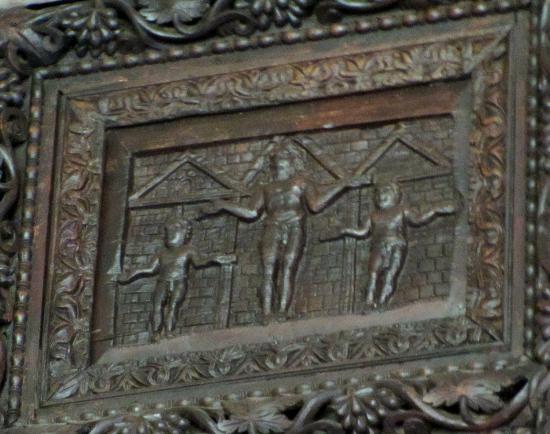
Santa Cecilia in Trastevere reidsitaly.com
The rather bland, 18th-century interior of this convent church hides the fact that it dates from 820, and contains not only one of the greatest frescoes from late medieval Rome, but also the ruins of a Rom patrician house underneath.
The Martyrdom of St. Cecilia
After locking Cecilia in her own steam room for three days failed to do her in---indeed, Cecilia came out singing, for which she later was declared the patron saint of music--the executioners tried decapitating her. The three allowed strokes of the axe failed to finish the job however, and Cecilia held on for another three days, slowly bleeding to death and converting hundreds in the process with her show of piety (and this obvious evidence of the power of the God protecting her).
The house--parts of which you can still visit underneath the church--was, supposedly, once the home of Saint Cecilia.
Celcilia was a powerfu Roman patrician who was killed in AD 230 for complicated political reasons--most of which had to do with the fact that she was (a) influential, (b) vocal in her politics, and (c) a woman.
Since the Roman prosecutors used her devotion to the then-illegal cult of Christianity as the chief accusation against her, she also became an early martyr of the church.
The Roman ruins beneath the church
From a door on the left aisle, you can pay a few euro to descent to the basement and wander around those Roman ruins beneath the church (as well as see the odd, riotously decorated crypt under the altar).
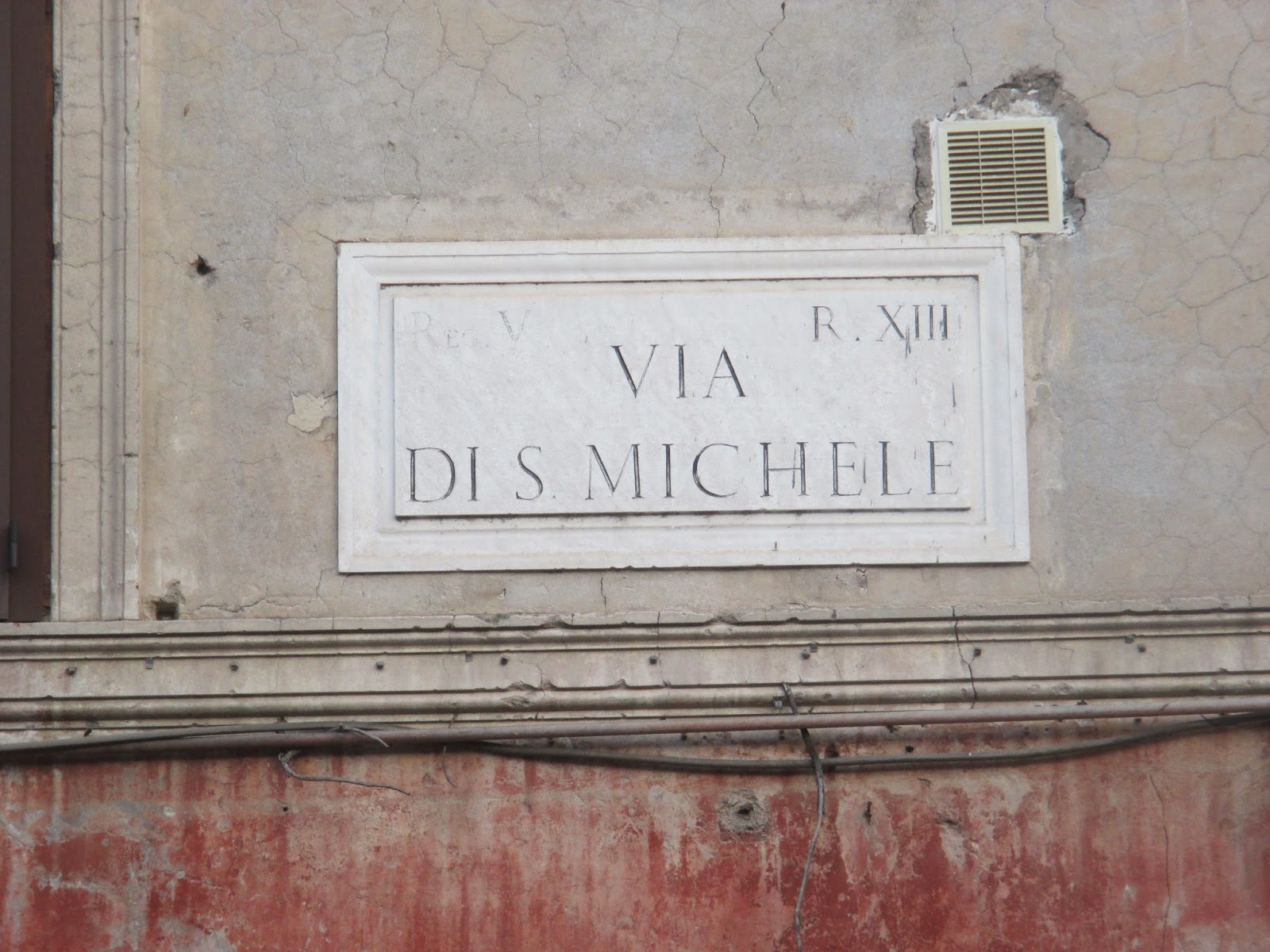 |
| The church is even located on the Street of St. Michael. How cool is that? |
Santa Cecilia in Trastevere ★
This Trastevere church looks like nothing much... until you pay the nuns to sneak downstairs to see remnants of ancient Rome, or upstairs to see precious frescoes by medieval master Pietro Cavallini
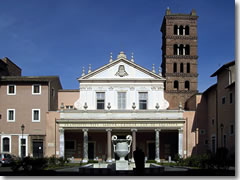 The
rather bland, 18th-century interior of this convent church hides the
fact that it dates from 820, and contains not only one of the greatest
frescoes from late medieval Rome, but also the ruins of a Roman
patrician house underneath.
The
rather bland, 18th-century interior of this convent church hides the
fact that it dates from 820, and contains not only one of the greatest
frescoes from late medieval Rome, but also the ruins of a Roman
patrician house underneath. The Martyrdom of St. Cecilia
After locking Cecilia in her own steam room for three days failed to do her in—indeed, Cecilia came out singing, for which she later was declared the patron saint of music—the executioners tried decapitating her. The three allowed strokes of the axe failed to finish the job however, and Cecilia held on for another three days, slowly bleeding to death and converting hundreds in the process with her show of piety (and this obvious evidence of the power of the God protecting her).
 The house —parts which you can still visit underneath the church—was, supposedly, once the home of Saint Cecilia.
The house —parts which you can still visit underneath the church—was, supposedly, once the home of Saint Cecilia. Cecilia was a powerful Roman patrician who was killed in AD 230 for complicated political reasons—most of which had to do with the fact that she was (a) influential, (b) vocal in her politics, and (c) a woman.
Since the Roman prosecutors used her devotion to the then-illegal cult of Christianity as the chief accusation against her, she also became an early martyr of the church (see the box to the right).
The bulk of the interior is a yawning dull take on baroque style, but the lovely mosaic in the apse dates from the ninth century, when Pope Paschal I rebuilt the church and brought Cecilia’s body from the catacombs to rebury her beneath the altar.
Under the present altar, with its Guido Reni painting and beautiful Arnolfo di Cambio baldacchino of 1283, lies Stefano Maderno’s touching 17th-century statue of St. Cecilia. She is lying on her side in repose with her face turned from us, a slit across her neck the only sign of her violent death.
Maderno was on hand to make sketches when Cardinal Sfondrati opened the saint's tomb in 1599, and they found Cecilia perfectly preserved under a gold funeral shroud.
The Roman ruins beneath the church
From a door on the left aisle, you can pay a few euro to descend to the basement and wander around those Roman ruins beneath the church (as well as see the odd, riotously decorated crypt under the altar).This closes half an hour before the church itself.
Be sure afterward to ask the nun on duty if you can please see the “affreschi di Cavallini”—traditionally viewable only on Tuesdays, Thursdays, and Sundays, but lately on other dasy as well. (If no one is on duty, ring the bell at the door on the left aisle; you’ll have to pay the nun a few euro to walk you up to the frescoes.)
The Cavallini frescoes hidden upstairs
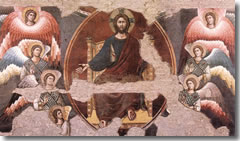
Detail from The Last Judgment by Pietro Cavallini.
Cavallini painted this in 1293 in a magnificent break from formulaic Byzantine painting, just as his contemporary Giotto was revolutionizing art in central Italy.
For the first time, each character has a unique face and personality, and all are highly modeled with careful shading and color gradients.
Take as much of it in as possible before the nun shoos you back downstairs.
- See more at: http://www.reidsitaly.com/destinations/lazio/rome/sights/scecilia_trastevere.html#sthash.oTHAWzxb.dpuf
 |
| Bath |
 |
| Used to store grain |
















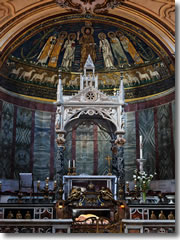



















No comments:
Post a Comment